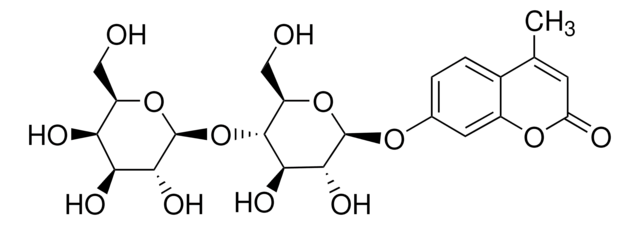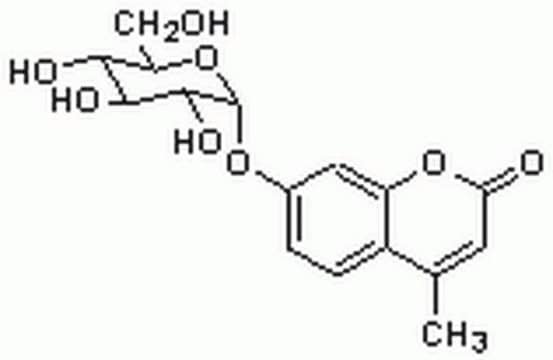M6018
4-Methylumbelliferyl β-D-cellobioside
glucanase substrate, fluorogenic, ≥98.00% (TLC), powder
Synonym(s):
4-Methylumbelliferyl beta-D-cellobioside
Select a Size
¥28,300
Available to ship onApril 07, 2025Details
Select a Size
About This Item
¥28,300
Available to ship onApril 07, 2025Details
Recommended Products
Product Name
4-Methylumbelliferyl β-D-cellobioside, glucanase substrate
Quality Level
Assay
≥98.00% (TLC)
form
powder
solubility
water: 19.60-20.40 mg/mL, clear, colorless to faintly yellow
storage temp.
2-8°C
SMILES string
CC1=CC(=O)Oc2cc(O[C@@H]3O[C@H](CO)[C@@H](O[C@@H]4O[C@H](CO)[C@@H](O)[C@H](O)[C@H]4O)[C@H](O)[C@H]3O)ccc12
InChI
1S/C22H28O13/c1-8-4-14(25)32-11-5-9(2-3-10(8)11)31-21-19(30)17(28)20(13(7-24)34-21)35-22-18(29)16(27)15(26)12(6-23)33-22/h2-5,12-13,15-24,26-30H,6-7H2,1H3/t12-,13-,15-,16+,17-,18-,19-,20-,21-,22+/m1/s1
InChI key
PRTGXBPFDYMIJH-MKQZUAMYSA-N
Application
Biochem/physiol Actions
Storage Class Code
11 - Combustible Solids
WGK
WGK 3
Flash Point(F)
Not applicable
Flash Point(C)
Not applicable
Personal Protective Equipment
Regulatory Listings
Regulatory Listings are mainly provided for chemical products. Only limited information can be provided here for non-chemical products. No entry means none of the components are listed. It is the user’s obligation to ensure the safe and legal use of the product.
JAN Code
M6018-100MG:
M6018-VAR:
M6018-500MG:
M6018-500MG-PW:
M6018-100MG-PW:
M6018-BULK:
Choose from one of the most recent versions:
Certificates of Analysis (COA)
Don't see the Right Version?
If you require a particular version, you can look up a specific certificate by the Lot or Batch number.
Already Own This Product?
Find documentation for the products that you have recently purchased in the Document Library.
Customers Also Viewed
Active Filters
Our team of scientists has experience in all areas of research including Life Science, Material Science, Chemical Synthesis, Chromatography, Analytical and many others.
Contact Technical Service














